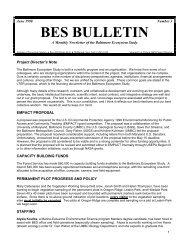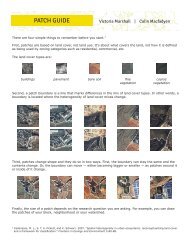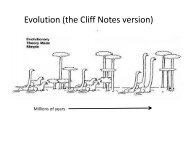Investigations in Urban Soils - Baltimore Ecosystem Study
Investigations in Urban Soils - Baltimore Ecosystem Study
Investigations in Urban Soils - Baltimore Ecosystem Study
Create successful ePaper yourself
Turn your PDF publications into a flip-book with our unique Google optimized e-Paper software.
Draft 2 - (9.28.04)<br />
<strong>Soils</strong> <strong>Urban</strong> <strong>in</strong> <strong>Investigations</strong><br />
b. Advanced students may benefit from writ<strong>in</strong>g a formal report, us<strong>in</strong>g a<br />
scientific paper as a rough model. This process takes days of revision<br />
and teacher and peer review.<br />
c. Create a class poster through collective effort. Split the class <strong>in</strong>to groups.<br />
Each group chooses to work on one portion of a formal report. Comb<strong>in</strong>e<br />
all groups’ writ<strong>in</strong>g, graphs, and photos onto one large poster board. See<br />
an example of a cooperative report (Student Work Sample #5), and the<br />
f<strong>in</strong>al poster (Student Work Sample #9).<br />
d. Students may get excited and want to create <strong>in</strong>formational placards for<br />
the property they studied. Have them select <strong>in</strong>formation they consider<br />
important for people to know about soil, earthworms, habitats; and<br />
<strong>in</strong>formation that is just pla<strong>in</strong> fasc<strong>in</strong>at<strong>in</strong>g, like the exotic species orig<strong>in</strong>s <strong>in</strong><br />
<strong>Baltimore</strong>. Ask permission to <strong>in</strong>stall the placards permanently on the<br />
property.<br />
e. If you have access to a digital camera, students may like to make a<br />
photo-journal of their research for the Internet. Even more helpful to<br />
future student groups would be high-quality photographs of various<br />
earthworm species. The more experience students get with see<strong>in</strong>g<br />
examples of Asian and European worms, the better they will be at quick<br />
identification <strong>in</strong> the field.<br />
f. Some students benefit from us<strong>in</strong>g visuals to organize their ideas.<br />
Encourage them to create a concept map of any relationships they<br />
discovered between earthworm habitat and earthworm populations. The<br />
concept map would also help students reflect on the <strong>in</strong>vestigation process<br />
by retrac<strong>in</strong>g the steps from their orig<strong>in</strong>al hypothesis, <strong>in</strong>vestigation, and<br />
results to new hypotheses and <strong>in</strong>vestigations, and so on.<br />
g. Results may also be reported <strong>in</strong> creative formats: diorama, posters, skits,<br />
radio show, etc.<br />
h. If worms were preserved, they should be displayed appropriately. A<br />
pr<strong>in</strong>ted slip of paper can be placed <strong>in</strong> the preservative solution as a label.<br />
See examples of stream fixed worms from a stream site and field site.<br />
See what students had to say about this project: Student Survey 2003.<br />
page 36 <strong>Baltimore</strong> <strong>Ecosystem</strong> <strong>Study</strong><br />
– <strong>Investigations</strong> <strong>in</strong> <strong>Urban</strong> <strong>Soils</strong>






